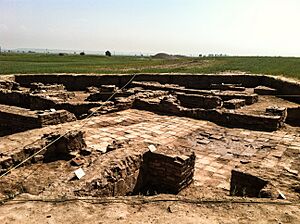Gundeshapur facts for kids
|
|

The ruins of Gundeshapur
|
|
| Alternative name | Weh-Antiyok-Shapur |
|---|---|
| Location | Khuzestan Province, Iran |
| Region | Iranian plateau |
| Coordinates | 32°17′N 48°31′E / 32.283°N 48.517°E |
| Type | Settlement |
| Part of | Sasanian Empire |
| History | |
| Founded | 3rd-century CE |
| Periods | Late antiquity to Middle Ages |
| Cultures | Iranian, Aramaic, Greco-Roman |
| Site notes | |
| Condition | Ruined |
Gundeshapur (also spelled Gondēshāpūr) was an important ancient city in what is now Iran. It was a major center for learning and knowledge during the Sasanian Empire. Imagine it as a super-school and hospital all in one!
This city was home to the famous Academy of Gundeshapur. This academy had a teaching hospital, a large library, and was a place for advanced studies. It was founded by the Sasanian Emperor Shapur I.
Today, you can find the ruins of Gundeshapur in the Khuzestan Province of southwest Iran. They are located near the modern town of Dezful.
Gundeshapur was a very important place for many centuries. It continued to be a center of learning even after the Muslim conquest of Persia in 638 CE. Later, Ya'qub ibn al-Layth al-Saffar, a powerful leader, made Gundeshapur his home. His tomb is still a notable site there.
Contents
What's in a Name?
The name Gundeshapur has a few possible meanings. It might come from a Persian phrase meaning "acquired by Shapur." Another idea is "military fortress of Shapur." Some scholars also think it means "Better-than-Antioch of Shapur."
In different ancient languages, the city had other names. In Classical Syriac, it was called Bēth Lapaṭ. In Greek, it was known as Bendosabora.
How Gundeshapur Became a Center of Learning
Shapur I Founds the City
The city of Gundeshapur was founded by Shapur I, the "King of Kings" of the Sasanian Empire. This happened after he conquered the Roman city of Antioch in 256 CE. Gundeshapur was built between the cities of Susa and Shushtar.
Shapur I wanted a place to settle Roman prisoners of war. Over time, it became a royal winter home for the Sasanian kings. It also served as the capital of the Khuzistan province. Gundeshapur was one of the four main cities in this area. Many Christians lived in Gundeshapur, and it was an important religious center for them.
A Hub for Knowledge
Gundeshapur truly became famous for medicine and learning under the rule of Khosrau I (531-579 CE). He was also known as Anushiravan, meaning "The Immortal."
Khosrau I welcomed many Greek philosophers and Nestorian Assyrians. These people were seeking safety from religious challenges in the Byzantine empire.
The emperor asked these newcomers to translate important texts. They translated Greek and Syriac books into Pahlavi, the language of the time. These translations covered many subjects, including medicine, astronomy, and philosophy.
Bringing Knowledge from the East
Anushiravan also looked to the East for knowledge. He sent a famous physician named Borzouye to invite scholars from India and China to Gundeshapur.
These visitors translated Indian texts on astronomy, mathematics, and medicine. They also translated Chinese texts about herbal medicine and religion. Borzouye himself is said to have translated the popular Indian story collection Pañcatantra from Sanskrit into Persian.
Many Assyrians also settled in Gundeshapur in the 5th century. Many of them were doctors from Urfa, which was a leading medical center at the time. Teaching at the Academy of Gundeshapur was done in Syriac.
Gundeshapur Under Islamic Rule
The Sasanian Empire fell to Arab-Islamic armies in 638 CE. However, the Academy of Gundeshapur continued to operate for several centuries. It adapted and became known as a Muslim center for higher learning.
In 832 CE, Caliph al-Ma'mūn founded the Bayt al-Hikma, or House of Wisdom, in Baghdad. This new center used many of the methods from Gundeshapur. Many of its staff were graduates from Gundeshapur. They had learned a lot about Indian, Greek, and Iranian medical traditions.
Over time, the main intellectual center shifted to Baghdad. This meant there were fewer mentions of universities or hospitals in Gundeshapur in later writings. The last known head of the Gundeshapur hospital was Sābur bin Sahl, who passed away in 869 CE. What happened to the hospital after that is not fully known.
Gundeshapur played a key role in connecting medical knowledge from ancient civilizations like India and Greece with the new Islamic world. This helped knowledge flow smoothly from one era to the next.
What Do Scholars Think Today?
Some modern scholars have questioned how big and important the hospital at Gundeshapur truly was. They point out that there are not many surviving Persian writings that clearly describe it as a major medical center.
It's thought that a medical center at Gundeshapur might have been similar to the School of Nisibis. This school was a seminary where medical texts were studied, and it had a place where medicine was practiced. So, it might have been more like a school with a clinic, rather than a huge hospital as we imagine today.
Also, Gundeshapur's fame might sometimes be mixed up with that of Susa. Susa was another city nearby that was connected to Gundeshapur for administrative purposes. An ancient scholar named Ath-Tha'ālibi wrote that people in Susa were very skilled in medicine. This was because they learned from an Indian doctor and Greek prisoners. This knowledge was then passed down through generations.
However, this same writing could also support Gundeshapur's medical reputation. Susa might have been used to represent the whole local region, which included Gundeshapur. This idea is supported because the quote compares Susa to entire regions like Ahwāz and Fārs.
Images for kids
See also
- Academy of Gundeshapur
- Science in Persia
- List of hospitals in Iran
- School of Nisibis



